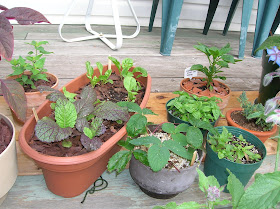I guess the plants aren't really getting enough sun in the back garden, unless a couple of spruce trees come down, or at least have the tops shortened. Having said that, I am actually quite impressed with how it turned out, considering this is my very first year as a *serious* gardener! I spend way too much time in the backyard, pottering, repotting, trimming, training, inspecting for pests, and all the associated quirks of being a gardener! I even have a log of stuff that I'm growing; plants and fungi. No, seriously, I do keep careful records of the various species and growing conditions in a Spreadsheet! Now I completely understand how Saxifrage Russell (of Kim Stanley Robinson's Mars Trilogy) can completely divert his skill and insight from Physics to Plants!
 |
80 species of plants, cacti, mesembrynths, and fungi currently in cultivation!
You can take a physicist out of the lab, but you can never take the lab out of the physicist! |
I found, as a child, that you must never believe the "rate of growth" of plants by other people and literature, as you can never reproduce the
exact condition of the other persons' garden. I noticed that each different part of the garden has it's own microclimate and might suit some species.
It is a big challenge to cultivate plants here, as we are subject to quite massive swings in temperature due to the proximity of the Rockies. Some of the more tropical and temperature sensitive seeds failed to germinate (Cananga odorata, Citrus hystrix, Etlingera elatior, Datura metel, amongst a few) or germinated to promptly die with the cool evenings (Capsicum frutescens). However, I think I have a better grasp of the fickleness of the temperature here, and a better idea of what plants to attempt and when, in the future.
Capsicum annuus var boliviae (Bolivian Rainbow Pepper)
This plant was started from seed last year in June/July. Under ideal conditions, it would have grown to maturity in 100-120 days and fruited by then. However, in cooler and temperate climate it only grew 4 true leaves last summer and "rested" for the rest of winter. This past few months it has picked up it's growth in a hurry and started to develop a woody main stem, which is indicative of imminent flowering.
 |
| Nice healthy plant, despite being battered by hailstones a few times. |
 |
| Small buds of maybe chilli flowers? |
Brassica oleracea var Romanesco (Romanesco broccoli - fractal broccoli)
The plants are doing very well, so well that they are attracting
Cabbage white butterflies (Pieris brassica) from somewhere ... I don't mind one or two caterpillars, but if there's a huge infestation they get picked off or sprayed. Sometimes I just brush the eggs off the leaves, after the butterflies flutters by, with a small pastry brush.
The stem on Bill has thickened somewhat - which I suspect means that the broccoli head is in the forming, as I couldn't really peer into the thick foliage to see the apex.
 |
| Thickening to cope with the weight of the broccoli head |
Cymbopogon citratus (Lemon grass)
I'm surprised the lemon grass thrived here - albeit the slow growth. I think that being a grass, it's more tolerant to temperature dips in the evenings. A new off-shoot has grown off the base of the main plant. When I repotted the grass recently I noticed a lot of vegetative offsprings forming from the root system. I guess in the time that I thought the grass wasn't growing (above ground) it was busy forming a massive root system and preparing off-shoots! Now I know better, I will put it in a bigger pot to start with.
 |
| Nothing beats fresh lemon grass stalks in your dinner |
Celosia argentaea var plumosa (Prince's Feathers)
Looks like they have recovered from the aphid infestation that nearly killed most of them. I will keep a closer watch on the Celosias in the future as they are very prone to aphids.
 |
| No sign of inflorescence yet. |
 |
| I'm glad I didn't consign them to the compost tea tub. They have bounced back wi | |
| th a vengeance. |
|
|
|
|
|
Borago officinialis (Borage - Starflower)
This plant will definitely be making a comeback next year. The bumblebees really love it! I spent many (too much?) hours watching the bumblebees bumbling around the petals. At least 2 different species of bumbles keep coming back to the Borage.
Helianthus annuus (Sunflower)
I finally have a sunflower casualty in the bad weather. One of the Red Sun sunflowers got decapitated close to the base. Two remaining ones are now staked against the wind. Might have to resort to just growing them in pots next year.
 |
Out of the three stooges, Curly got whacked. The "stump" however is showing
signs of a new bud forming. Or maybe I'm just wishful :( |
Cocot and Peter are doing well. Peter has a flower bud forming in the apex. Maybe in 2 weeks we'll see the bloom? Cocot leafed out very vigorously, and is showing signs of branching out! It was blown over in the strong winds last week, but thankfully it wasn't hurt. Now it is staked up with two support bamboo canes.
 |
| Cocot in the Evil Plot |
 |
| Peter's flower |
 |
| Peter lives in a bigger pot now, with some amaranth, celosia, poppies and hypericum |
Papaver rhoeas (Shirley poppy)
No, it's not opium poppy, so quit waggling your finger at me! I'm glad I didn't take the normal "advice" of thinning out the weaker plants. I've got a few interesting strains from this batch alone. The pink ones are ubiquitous and vigorous. Red ones are a bit slower growing. Red Flying Saucer is next. Peach coloured strain is interesting, and surprise of the day - a white papaver rhoeas! They are rare :)
 |
| Yes, it's out of focus. My camera can be temperamental. But behold, a peach poppy! |
 |
| I've never ever seen a peach poppy before. |
 |
| Nice Flanders' Field Red Poppy. I know were this poppy should be ... >:) |
 |
First white poppy of Papaver rhoeas strain I've seen. Usually only turkish (somniferum)
have white petals. I don't think growing contraband substances is such a good idea ... |
 |
| I hope the plant survives long enough for the seed pod to mature. It's looking rather sad. |
Cucurbita pepo (Pumpkin)
Just for shits and giggles I started a couple of pumpkin seeds that I saved up from last year's Hallowe'en. They grow really quick, but I think I should have started them in April. Maybe, just maybe, it will survive the frost and I'll have a pumpkin for this year's Hallowe'en.
 |
The pumpkin plants are the ones 10 and 11 o'clock. It's sharing the bigger pot with some
pepper plants, an onion, a couple of Triffids and some sunflowers. |
Amaranthus cruentus (Red Velvet Amaranth)
I am actually really curious and eager to harvest (and eat) the Amaranth grains from these plants. I've got lots of seed in the baggie, so I figure I might as well enjoy it!
|
 |
| The Tassels are forming nicely. There's even axilliary shoots coming out on the sides. |
Lavandula angustifolia var Munstead & Vera, Nepeta cataria, Ocimum basilicum, Echinacea purpurea and Helianthus annuus var Dwarf Teddybear (Munstead and Vera Lavenders, Catnip, Basil, Echinacea and Dwarf Sunflower)
 |
Clockwise from 6 o'clock: Catnip, Munstead lavender, Vera lavender, Basil, Echinacea
and Dwarf Teddybear Sunflower |
The Vera lavender that I germinated from seed is very slow in catching up with the Munstead.
 |
| Vera, Vera, what has become of you? |
Stevia rebaudiana (Sugarleaf)
Very slow growing. I suspect the low evening temperature has a big effect on it.


























































